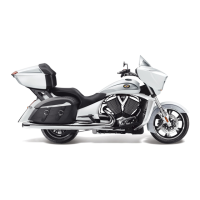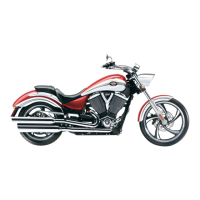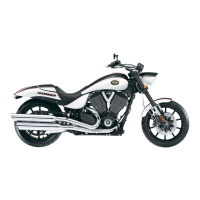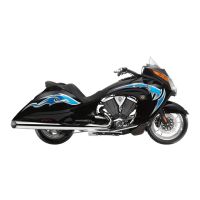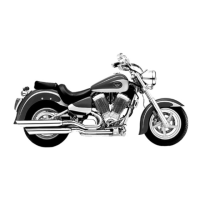Safety Page: 9 Safe Riding Practices Guidelines for safe motorcycle operation, covering skills, awareness, and defensive riding.
Protective Apparel Recommendations for wearing appropriate protective gear for rider safety.
Use of Accessories Guidelines for selecting and installing accessories to maintain motorcycle stability and safety.
Modifications Information on how modifications can affect warranty, safety, and legality.
Carrying Cargo Guidelines for safely attaching and distributing cargo and accessories on the motorcycle.
Saddlebags Safety precautions and guidelines for operating the motorcycle with saddlebags.
Safety Maintenance Procedures and recommendations for maintaining the motorcycle's safety features.
Instruments, Features and Controls Page: 23 Ignition Switch Explanation of the ignition switch operation and its different positions (OFF, ON, PARK).
Clutch Lever Description of the clutch lever operation for engaging and disengaging the clutch.
Throttle Control Grip Instructions on how to use the throttle control grip to manage engine speed and power.
Tilt Sensor Explanation of the tilt sensor's function to stop the engine if the motorcycle tips.
Brakes Overview of the braking system, including front and rear brake controls.
Pedal Adjustment Instructions for adjusting the brake and gear shift pedal positions.
Sidestand Information on locating, operating, and inspecting the motorcycle's sidestand.
Saddlebag Lock Instructions for locking and unlocking the saddlebag doors using the ignition key.
Fuel Cap Instructions for locking and unlocking the fuel cap using the ignition key.
Tool Kit Listing of tools provided in the kit for basic maintenance.
Pre-Ride Inspections Page: 40 Engine Oil Level Procedure for checking and maintaining the correct engine oil level.
Fuel Level Instructions for checking the fuel level and refueling the motorcycle.
Tire Inspection Inspect tire pressure, condition, and tread depth for safe operation.
Front Brake Lever Procedure for checking the front brake lever operation and freeplay.
Brake Lines Inspection of brake hoses and connections for leaks or damage.
Brake Pads Procedure for inspecting brake pads for wear and checking calipers for leaks.
Throttle Inspection of throttle grip rotation and returnability.
Front Suspension Inspection of front forks for oil leaks and smooth suspension operation.
Steering Procedure for checking steering smoothness and ensuring cables do not interfere.
Rear Suspension Checking rear shock absorber movement and air pressure for proper suspension.
Drive Belt Inspection of drive belt tension, teeth, and overall condition.
Sidestand Inspection of the sidestand for proper operation, pivot bolt, and wear pad.
Fasteners Inspection of all chassis and engine fasteners for looseness or damage.
Operation Page: 48 Engine Break-In Crucial procedures for breaking in the engine during the first 500 miles for optimal performance and durability.
Fueling Guidelines and warnings for safely refueling the motorcycle with the correct fuel.
Shifting Gears Detailed guide on shifting gears smoothly and safely in the six-speed transmission.
Accelerating Instructions on how to accelerate smoothly and safely, including shift points.
Braking Proper techniques for applying brakes gradually for maximum effectiveness and control.
Parking Procedures for parking on level, sloped, or soft surfaces, including safety precautions.
Maintenance Page: 57 Road Tests Importance of performing a road test after service to ensure proper fit and operation.
Break-In Maintenance Details on the required break-in maintenance at 500 miles for optimal engine performance.
Major Maintenance Information on major repairs and when to consult the VICTORY Service Manual or dealer.
Maintenance Log Guidance on recording all maintenance performed in the logbook.
Air Filter Instructions for inspecting and replacing the motorcycle's air filter.
Drive Belt Condition Guidelines for inspecting the drive belt for wear and damage, and when to replace it.
Drive Belt Cleaning Instructions for cleaning the drive belt to maximize its life and minimize noise.
Rear Brake Fluid Procedure for checking and adding rear brake fluid, and inspecting for leaks.
Wheel Inspection Inspection of wheels for cracks or damage, and replacement if necessary.
Tire Inspection Inspect tire pressure, condition, and tread depth for safe operation.
Spark Plugs Procedure for replacing spark plugs, including specifications and torque values.
Battery Safety warnings and information about the motorcycle's battery.
Battery Removal Step-by-step instructions for safely removing the motorcycle battery.
Battery Charging Guidelines for charging the motorcycle battery, including recommended rates and times.
Fastener Inspection Inspection of all chassis and engine fasteners for looseness, damage, or missing parts.
Side Covers Instructions for removing and reinstalling the motorcycle's side covers.
Fuse Replacement Instructions for replacing fuses, including recommended amperages and locations.
Electrical Precautions Precautions to avoid disruption of electrical signals and potential system malfunctions.
Road Test Importance of performing a road test in a safe area after servicing components.
Fastener Torque Reference for fastener torque values for various motorcycle components.
Cleaning and Storage Page: 89 Washing the Motorcycle Detailed instructions for washing the motorcycle using standard and spray-rinse methods.
Quick Clean-Ups Tips for quick cleaning between washes or when water is unavailable.
Fuel Stabilizer Instructions for using fuel stabilizer to protect the fuel system during storage.
Tire Inflation Guidance on inflating tires to the correct pressure before storage.
Engine Protection Measures to protect the engine from deposits and corrosion during storage.
Battery Care Instructions for removing, cleaning, storing, and maintaining the motorcycle battery.
Rodents Tips for deterring rodents and protecting the motorcycle during storage.
Warranty Page: 97 Coverage Details on what warranty defects are remedied and where warranty service can be obtained.
Limitations Information on what is excluded from the Emissions Control System Warranty.
Limited Liability Statement on the limited liability of VICTORY under the Emission Control System Warranty.
Legal Rights Information on specific legal rights granted by the warranty, which may vary by state.
Registration Procedure for registering the motorcycle for warranty coverage and the importance of initial dealer preparation.
Specifications Page: 101 Dimensions Technical specifications for motorcycle dimensions, including length, width, height, and wheelbase.
Weight Specifications for dry weight, wet weight, and maximum load capacities.
Capacities Technical specifications for engine oil capacity, fuel capacity, and fuel reserve.
Engine Detailed specifications for the motorcycle's engine, including type, displacement, and cooling system.
Chassis Specifications related to the motorcycle's chassis, suspension, brakes, and storage volume.
Drive System Specifications for the drive system, including final drive type, transmission, and clutch.
Electrical Specifications for the electrical system, including alternator, battery, and lights.
Fuel Recommendation Recommended fuel type, octane rating, and precautions for using ethanol or methanol blends.
Audio System Operation Page: 106 Audio System Power How to turn the audio system on and off, and what displays when the system is active.
Audio Volume Control Instructions on how to adjust audio volume for speakers and turn them on or off.
Audio Tuning Instructions on how to tune radio stations and use seek/scan functions.
Memory Presets How to store and recall favorite radio stations using the audio system's memory presets.
Audio Mode Menus How to enter and navigate audio mode menus for settings like Bass, Treble, Fader, and Speakers.
CB LO/DX Mode Explanation of local and distant modes to adjust CB radio sensitivity and noise levels.
AUX Mode How to select AUX mode for iPod or other MP3 players, and NAV MP3 for navigation units.
XM Display How to set the XM radio screen to display channel name or category.
XM Category How to set the music selection category for XM radio channels.
Weather Band (WX) Information about NOAA weather band channels and how to access them.


